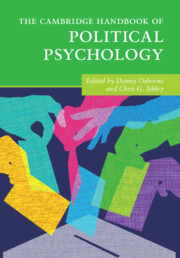Book contents
- The Cambridge Handbook of Political Psychology
- The Cambridge Handbook of Political Psychology
- Copyright page
- Dedication
- Contents
- Figures
- Tables
- Contributors
- Part I Foundations of Political Psychology
- 1 Political Psychology
- 2 The Evolutionary Basis of Political Ideology
- 3 Genetic Contributions to Political Phenomena
- 4 The Psychology and Neuroscience of Partisanship
- 5 The Personality Basis of Political Preferences
- 6 The Structure, Prevalence, and Nature of Mass Belief Systems
- 7 The Psychology of Public Opinion
- 8 Rational Choice and Information Processing
- 9 Emotions and Politics
- 10 The Developmental Science of Politics
- Part II The Politics of Intergroup Attitudes
- Part III Contemporary Challenges to Democracy
- Part IV Diversifying Perspectives in Political Psychology
- Index
- References
4 - The Psychology and Neuroscience of Partisanship
from Part I - Foundations of Political Psychology
Published online by Cambridge University Press: 17 February 2022
- The Cambridge Handbook of Political Psychology
- The Cambridge Handbook of Political Psychology
- Copyright page
- Dedication
- Contents
- Figures
- Tables
- Contributors
- Part I Foundations of Political Psychology
- 1 Political Psychology
- 2 The Evolutionary Basis of Political Ideology
- 3 Genetic Contributions to Political Phenomena
- 4 The Psychology and Neuroscience of Partisanship
- 5 The Personality Basis of Political Preferences
- 6 The Structure, Prevalence, and Nature of Mass Belief Systems
- 7 The Psychology of Public Opinion
- 8 Rational Choice and Information Processing
- 9 Emotions and Politics
- 10 The Developmental Science of Politics
- Part II The Politics of Intergroup Attitudes
- Part III Contemporary Challenges to Democracy
- Part IV Diversifying Perspectives in Political Psychology
- Index
- References
Summary
Why have citizens become increasingly polarised? One answer is that there is increasing identification with political parties – a process known as partisanship. This chapter focuses on the role that social identity and partisanship play in contemporary politics. Partisan identities influence political preferences, such that partisans are more likely to agree with policies that were endorsed by their political party, regardless of the policy content, and, in some cases, their own ideological beliefs. We will describe how partisanship mirrors other forms of social identity, both behaviourally and in the brain. However, partisanship also has distinct biological origins, and consequences in political domains such as fake news sharing, conspiracy theory beliefs, and voting behaviour. Our chapter focuses on the psychology and neuroscience of partisanship within broader sociopolitical contexts.
- Type
- Chapter
- Information
- The Cambridge Handbook of Political Psychology , pp. 50 - 67Publisher: Cambridge University PressPrint publication year: 2022
References
- 1
- Cited by



